Annual phlox: description of varieties and cultivation features

Phlox are flowers that can decorate any garden. This option will be an excellent solution for those gardeners whose site seems boring and monotonous. The large number of varieties and variety of this plant made it popular among summer residents. In addition, growing annual phlox is not as difficult a task as it might seem.


General characteristics
Phlox are herbaceous plants belonging to the cyanide family. In total, there are about 85 species in the genus, but gardeners grow no more than 40 of them. Let's consider some of the features of the culture.
- The bushes of the plant look very bright, instantly catch the eye with their flowers. Bright flowers have a pleasant aroma.
- Most of the species are perennial plants. However, the species called Drummond is the only annual.
- The stems of the plant are very thin, but straight. The average height of a phlox is 60 centimeters. But when growing varieties of semi-shrubs in a sunny place, you can get a plant with a height of 130 centimeters or more.
- Leaves are oval, juicy, green. The placement is opposite.
- The color range of phlox flowers is very diverse and rich. There are white, red, pink, beige, yellow and other shades. It happens as a monochromatic color, and darkened towards the center. The shape of the petals is most often needle-like, but sometimes it is round.
- The diameter of a single flower can range from 3 to 5 centimeters.
- The buds are collected in corymbose inflorescences. One inflorescence can contain from one to three dozen buds.
- As for the flowering of phlox, it usually begins in June and ends closer to November.
Ripening of seeds is carried out in an oval fruit-box. Once the seeds are fully ripe, they can be harvested.



Review of popular varieties
Before proceeding with the study of phlox varieties, it should be said that they were all bred using the Drummond annual, which was already mentioned earlier. The name of the variety comes directly from its discoverer - British botanist Thomas Drummond.
Phlox has quite a few varieties, but we will focus only on the most popular of them.
- "Twinkling Star". This is a very small bush, no more than 30 centimeters high. The "twinkling star" has pointed double petals that form small buds. The variety is ideal not only for growing in the garden, but also on the balcony.

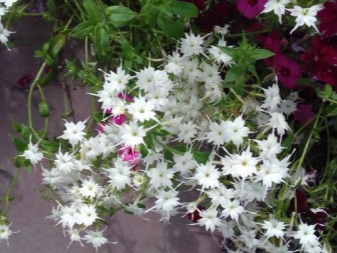
- "Star Rain". The average height of this variety is about 50 centimeters. Stems are usually straight, but branching is also found. Like many other varieties, the flowers of this one resemble stars gathering in cluster inflorescences. Star Rain is popular among gardeners for its strong and pleasant aroma. It is not suitable for growing in the shade.


- "Promise pink". A low-growing plant, whose average height is no more than 20 centimeters. This variety is characterized by abundant and long flowering, which is why it is often used for decorative purposes. The flowers are pink, large.
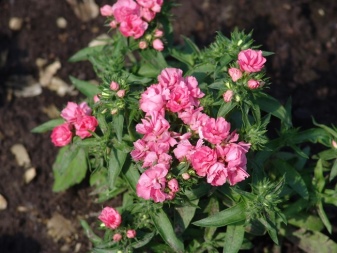

Landing rules
An important task on which the further growth and development of a plant depends is its planting. As is known, annual phloxes reproduce by means of seeds... Since their outer shell is dense, it is recommended to soak them in a solution of light pink potassium permanganate a few days before sowing, and then dry them in direct sunlight.
The best sowing period is late autumn. The growth of such plants and flowering will occur in the spring, in a fairly short time. The optimum distance between the seeds is 5 cm. For young plants - 20 cm. Having arranged the seeds, cover them with earth. It is best to use store-bought primer. In order to prevent freezing in winter, crops must be covered with snow.
It is possible to plant phlox in open ground in spring, but in this case, flowering should be expected at the end of summer. It is important that the ground is moist when planting.


Breeding options
Phlox bushes reproduce vegetatively, that is:
- layering
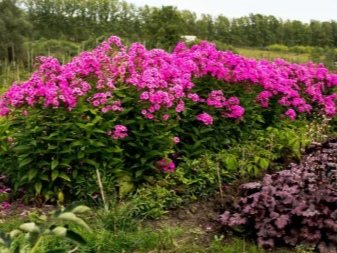

- cuttings

- dividing the bush

Nevertheless, one of the most common methods is seed propagation.
This method is popular in the northern regions. It allows you to achieve a longer flowering than when grown outdoors. It is recommended to plant at the very end of winter. The first shoots can be expected in two weeks. Flowering occurs in June.


This planting option, like planting in open ground, described earlier, involves the preparation of seeds. For their cultivation, a container is required, the walls of which are at least 15 centimeters. This is important because the phlox root system is quite well developed. It is equally important to provide a drainage hole in the bottom of the container.
As for the soil, it should be loose and have neutral acidity. It is recommended to use a soil mixture prepared from garden soil, compost and humus in a 1: 1: 1 ratio. To eliminate all kinds of bacteria and diseases, the mixture must be watered with a weak solution of potassium permanganate. The permissible soil thickness in the container is 6-8 cm.
It is important that it is sufficiently hydrated three days before planting.


Phlox seeds should be placed on wet ground at a distance of about three centimeters. Next, they need to be sprayed with a spray bottle and covered with polyethylene. The container with the seeds planted in it must be placed on the windowsill. The best temperature for proper germination is 22 degrees.
It is necessary to ventilate the crops every day, slightly removing the polyethylene. Condensation on the film must be shaken off. Another important task in the early days of phlox sowing is moisture. It is imperative to prevent the topsoil from drying out.


Care features
Phlox care at home must be thorough from the moment of landing.
- As mentioned earlier, the first shoots appear after one and a half or two weeks. After this time, the polyethylene is removed.
- It is recommended to periodically unfold the containers in different directions so that the sprouts are directed not only towards the sun. The optimal night temperature is 17 degrees.
- You should not water the sprouts abundantly, otherwise there is a risk of getting a black leg.
- In no case should the top layer of the soil be allowed to dry.
- To avoid burns, it is necessary to shade the plant from direct sunlight.
- As soon as the first leaves appear on the sprouts, they can be distributed in different containers without damaging the thin roots.
- You can fertilize the transplanted seedlings after about a week.
- Before finally planting the plants in the flower bed, you must apply top dressing once every two weeks.
- Also, a week before transplanting, the plant must be systematically tempered - taken out in the daytime to the street or loggia.
- It is recommended to disembark at the chosen place at the end of spring, best of all in the evening.


Now let's look at the rules for transplanting phlox to a permanent place.
These plants love partial shade with fertile soil. An excellent option would be a light, non-clay soil with a neutral reaction.If the soil is heavy, then compost or coarse sand should be added. It is important to prepare the place in the fall by digging up the ground and adding rotted manure. Liming of acidic soil is also obligatory.


Before you start planting, the seedlings must be well watered. Holes are dug at a distance of 20 cm from each other. Pour water into the resulting holes and add 150 g of ash. The seedling is set in a hole, the roots are covered with earth and carefully trampled down. The resulting plantings need to be watered with warm water, and the central part will need to be sprinkled with dry soil. During the first 14 days, it is necessary to ensure watering every two days, and in hot weather - every day. Experienced gardeners recommend pinching the main shoot on the 6th sheet.
Due to this, lateral stems are formed, which makes the bush visually more lush.


Another important thing when growing phlox is caring for planted seedlings. You need to know that this plant is extremely difficult to tolerate drought, however, excessive moisture is contraindicated for it, since there is a risk of fungal diseases. 10 liters of water is recommended for one square meter of planting. It is best to water after lunch, then loosen the soil and remove weeds.
To help the root system finally strengthen, the plant should be huddled at the beginning of summer. We must not forget about the support for tall varieties - this will protect the shoots from the wind. To reduce the evaporation of moisture, mulching with manure with a layer of 2-3 cm is capable.



For good flowering phlox you should take care of regular feeding, taking into account the growing season.
- At the very end of spring, when the first buds begin to appear, potash fertilizers are applied to the soil. To do this, add a glass of wood ash and one tablespoon of potassium sulfate to a bucket of water. This mixture significantly improves inflorescences and resistance to various diseases.
- Exactly two weeks later, phloxes must be fertilized with a solution of superphosphate, mixed in a ratio of 15 g per 10 liters of water. Watering must be strictly at the root.
- At the end of June, the best plant nutrition will be liquid manure, diluted in a proportion of 20 g per 10 liters of water. This procedure provides the plant with long and colorful flowering.
- As soon as the seed pods are finally formed, the phlox life cycle can be considered complete. In the fall, they can be fertilized with a phosphorus-potassium supplement. For this, 20 g of superphosphate, 10 g of potassium sulfate and 10 liters of ordinary water are taken. Phosphorus is also found in bone meal, which can be safely added to the soil during loosening. The quality of the seeds after such a procedure improves markedly.


Top dressing is best applied at sunset. Liquid fertilizers are given strictly after thorough watering, and dry fertilizers - immediately before watering or precipitation.
Diseases and pests
It is worth noting that phloxes are very weakly susceptible to infectious diseases. However, pests when growing this crop are quite common.
Nematode
Nematoda is a very dangerous pest. These are worms 1 mm in size, feeding on plant sap and settling in their tissues. They not only seriously harm one plant, but also transfer infections to others. The most common is the stem nematode, but there are also gall, root and leaf nematodes. They can cling to a plant through water, cuttings of other plants, or be carried by animals.
If the disease was detected at the beginning of its development, the plant can be helped. Affected stems must be cut at the root. In April, after the shoots grow up to 5 cm, you need to break off healthy shoots, rinse in running water and plant them in loose soil under a film shelter. Treat the soil three times with an interval of 20 days with "Fitoverm", and the roots before planting with "Piperazin".

Slugs
During the day, they hide in the soil or shelter.They feed after sunset, damaging cuttings, leaves, buds and other parts. They can be identified by the holes in the leaves and large veins. They are dangerous because they carry viruses and various diseases.
Beer is a great way to catch slugs. It is poured into jars so that the pest can drown in it. Banks are dug in and covered with lids, but so that there are gaps.
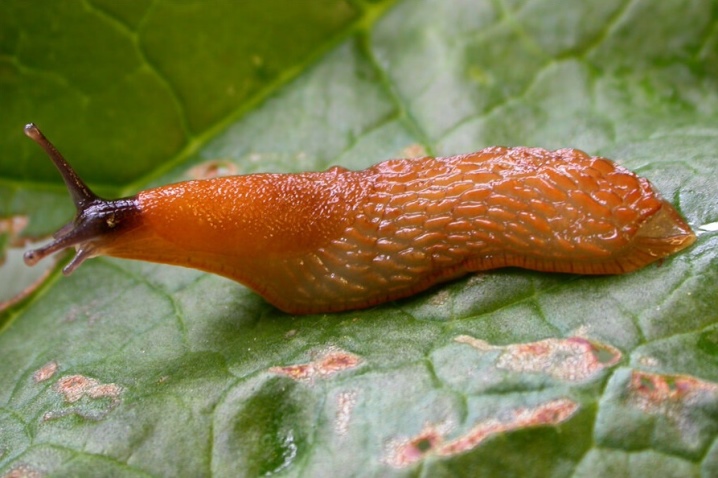
Scoops
These are caterpillars of butterflies, eating buds, cuttings, leaves and other parts. The plant begins to wilt, grows poorly and gradually rots. In this case, it is necessary to collect all the tracks and destroy. If the situation is neglected, then you need to use insecticides.

Examples in landscape design
Due to the wide range of colors, phloxes can perfectly complement any flower bed. The best combinations of phloxes are created with the following crops.
- Peonies. Steamed peonies with phlox can create a very original design. It is very important to select undersized phlox so that they do not hide the flowering of peonies.
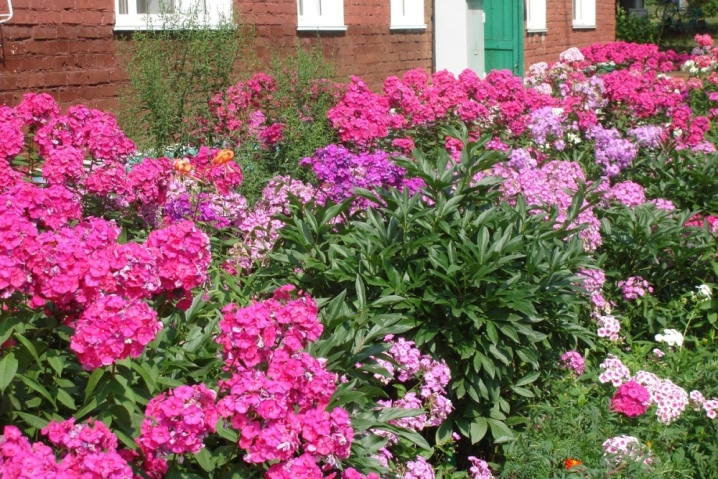
- Daylilies. Designed for landscaping, daylilies in combination with bright and variegated phloxes create an interesting, eye-catching combination.

Also great neighbors for phlox will be:
- hosts;

- astilbe;
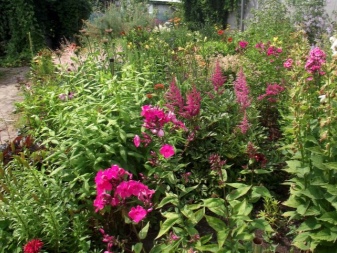

- saxifrage;

- purists;

- chippings;

- rejuvenated.

Phloxes are amazing, easy-care plants. You need to grow them tenderly and correctly, and only then will they please with their beauty.
Tips for planting phlox in the video.







































































































The comment was sent successfully.